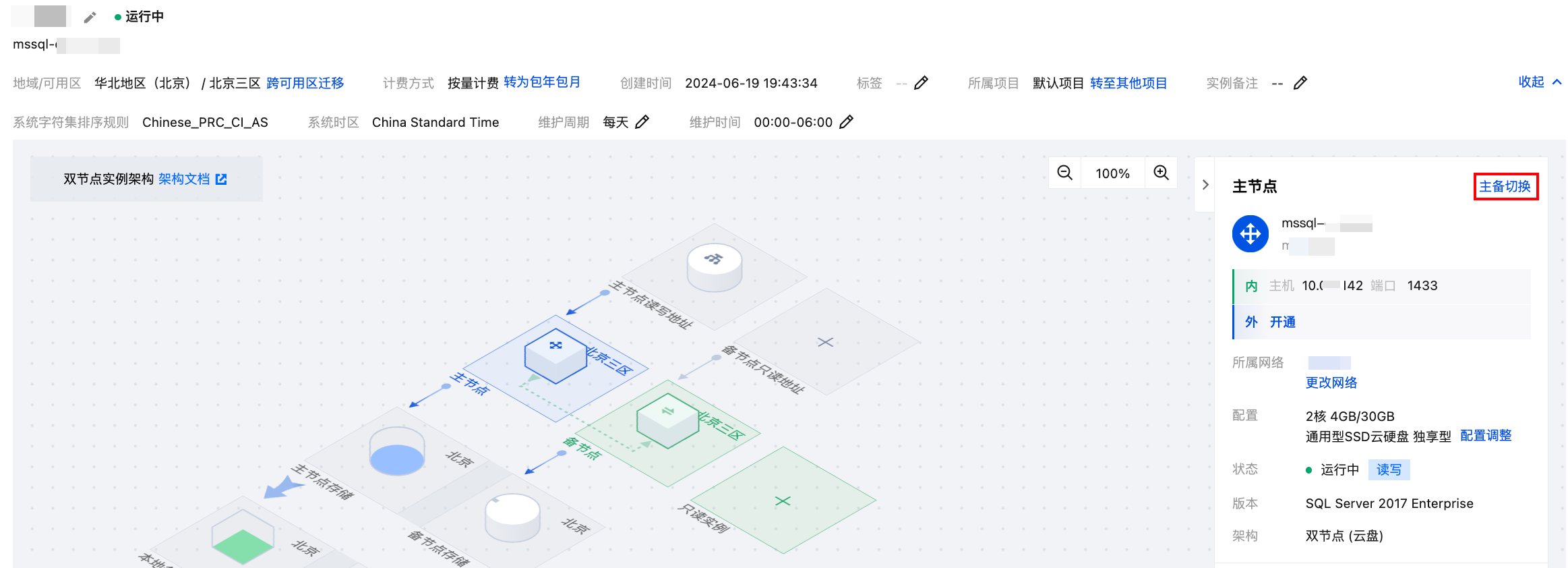手动主备切换
最后更新时间:2025-09-04 11:40:58
云数据库 SQL Server 支持切换实例的主库和备库。在实例出现故障时,将备用数据库切换为主数据库,以保证系统的可用性和数据的完整性,以上为实例遇到特殊情况例如故障时系统进行的自动切换,除此之外,您还可以通过控制台进行手动切换。
背景
在企业级应用中,数据库通常是关键的业务系统,一旦数据库出现故障或停机,将会对业务产生严重影响。因此,为了保证系统的可用性和数据的完整性,需要采用高可用性方案,如主备复制,主备切换是主备复制方案中的一种重要技术手段,可以在主数据库出现故障时快速切换到备用数据库,避免业务中断和数据丢失。
敏感操作接入 MFA 说明
为提升云账号的安全性,云数据库 SQL Server 支持了 MFA(Multi-Factor Authentication),即多因子认证,可以在用户名和密码之外,再增加一层保护。启用 MFA 设备校验后,在您操作销毁实例/修改网络/修改 IP 地址/重置密码/删除账号/重启实例/主备切换时会进行基于 MFA 动态码的二次身份验证,验证通过后方可执行操作。有关 MFA 的介绍以及开启操作保护请参见 MFA 设备。
前提条件
实例为双节点、多节点云盘版架构。
说明:
实例状态为运行中,并无其他任务执行中。
注意事项
主备库切换过程中,会有秒级别连接闪断。建议您在业务低谷期执行切换操作并确保应用具备重连机制。
主备库切换后,实例连接地址保持不变,原来的主实例会作为备实例,应用自动连接到新的主实例(即原备实例)。
主库与备库之间的数据复制方式默认为异步复制。
使用限制
操作步骤
1. 登录 SQL Server 控制台,在实例列表,单击实例 ID 或操作列的管理,进入实例详情页面。

2. 在实例详情页,右侧实例信息内,单击主备切换。

3. 在主备切换弹窗下,选择切换时间,勾选可用区切换时,会有秒级别的连接闪断,请确保业务具备重连机制,单击确定。
立即切换:主备可用区数据同步完成后会立即切换。
维护时间内:主备可用区数据同步完成后,会在下一个维护时间内进行主备切换,若选择在维护时间内切换,但因特殊情况需在未到维护时间内做切换,可在 SQL Server 控制台,单击对应实例操作列的立即切换。设置实例维护时间相关操作请参见 设置实例维护信息。
主备切换日志
热点问题
实例的主备库切换成功后,实例的地址是否变更?
切换后实例地址保持不变,原来的主实例会作为备实例,应用自动连接到新的主实例(即原备实例)。
手动切换后,如果对实例进行升级、升配等操作,是否会影响或者重置主备可用区信息?
切换后不会影响和重置主备可用区信息。
主实例下挂载有只读实例如何进行主实例的主备库切换?
有只读实例的主实例不支持主备切换,如仍要进行主备切换,需先释放只读实例,再进行主备切换,切换完毕后,再重新购买只读实例。
相关 API
API | 描述 |
接口(SwitchCloudInstanceHA)用于手动主备切换。 |
文档反馈

